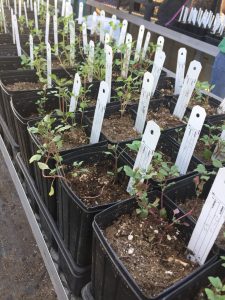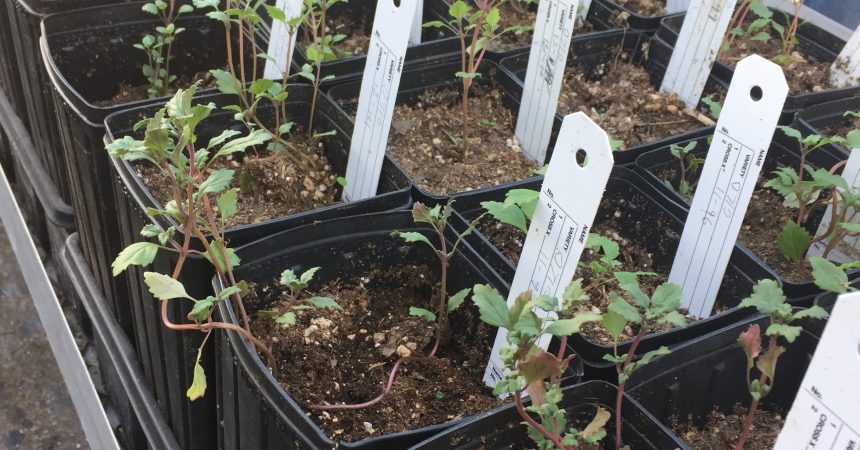Zoo InternQuest is a seven-week career exploration program for San Diego high school juniors and seniors. Students have the unique opportunity to meet professionals working for the San Diego Zoo, Safari Park, and the Institute for Conservation Research, learn about their jobs, and then blog about their experience online. Follow their adventures here on the Zoo’s Website!
While most people are aware of the conservation efforts for animals, plant conservation is often overlooked. However, people like Joe Davitt do just that. Mr. Davitt works in the Plant Conservation Department of San Diego Zoo Global’s Institute for Conservation Research. He’s involved in seed banking, where Mr. Davitt works to collect and freeze seeds from rare plants. The ultimate goal is to conserve the genetic diversity of plant species. San Diego Zoo Global has assisted in this effort by partnering with the national organization, the Center for Plant Conservation (CPC). San Diego Zoo Global also partners with the California Plant Rescue (CAPR). This organization aims to conserve all Californian plant species in some form, though the first priority is rare and endangered species. The Institute does their part by focusing on rare San Diegan and Southern Californian native plant species.
 Conserving the genetic diversity of these plants is sometimes complicated. While populations of animals can overlap and exchange genes over large distances, separated populations of plants can become very isolated. Sometimes these separate populations are genetically similar, but some populations can develop different gene pools. If they were similar, it wouldn’t matter if Mr. Davitt only collected seeds from one population. However, when the populations vary, it’s important to conserve the genetic diversity of each population. Figuring out whether or not seed collections are necessary from all populations requires expensive genetic testing and analysis. So, they operate by the motto “better safe than sorry.” The Institute tries to collect seeds from all the separated populations if possible.
Conserving the genetic diversity of these plants is sometimes complicated. While populations of animals can overlap and exchange genes over large distances, separated populations of plants can become very isolated. Sometimes these separate populations are genetically similar, but some populations can develop different gene pools. If they were similar, it wouldn’t matter if Mr. Davitt only collected seeds from one population. However, when the populations vary, it’s important to conserve the genetic diversity of each population. Figuring out whether or not seed collections are necessary from all populations requires expensive genetic testing and analysis. So, they operate by the motto “better safe than sorry.” The Institute tries to collect seeds from all the separated populations if possible.
So, what’s the point in collecting all these seeds? While they do help preserve the genetic diversity, seeds don’t do any use if they’re just perpetually frozen. Sometimes, restoration projects replant the seeds in the wild habitats they came from. This would boost the population count and help maintain genetic diversity. Mr. Davitt and his coworkers might also increase the reach of a population by planting seeds in areas where that species used to live but doesn’t anymore as their numbers have shrunk. Restoration can also look a little bit different than planting seeds on a hike. If a species is observed to have a difficult time growing when seeds are dispersed, they might instead germinate the seeds and transplant the small saplings.
When Mr. Davitt is out collecting seeds from rare plants, he only takes 3% to 5% of the population’s annual seed production. This keeps the wild population from suffering from the seed banking, but it also limits how many seeds the Institute has for restoration projects. Sometimes projects are funded to grow certain species at the greenhouse. Seed bulking is the practice of planting some of the seeds in a nursery then using the seeds they produce in restoration projects. This multiplies the available seeds to help populations that are really suffering. One species that the Institute is doing this for is Dudleya brevifolia. This small succulent only has 5 populations throughout Southern California. The seeds used to grow this ex-situ (off-site) collection were harvested from the smallest and most threatened population. While trampling and invasive weeds limit the wild plants’ growth, the ex-situ collection can flourish in ideal conditions. This year, the nursery-grown Dudleya brevifolia produced more flowers than the original population. Additionally, this species is perennial, so the same plants will produce more seeds each year that can be used to support the wild population.
Mr. Davitt’s work in plant conservation is important for sustaining the natural environments people have disrupted. Because these plants serve unique roles in their ecosystems, it’s important to conserve species that are becoming endangered. However, most action to conserve rare plants needs to be taken by scientists and land managers. Clearing away invasive weeds that shade small plants is one job that land managers do to promote the growth of native and endangered species. Through combined efforts between land managers and plant conservationists we can save rare species from extinction.
Carly, Conservation Team
Week Two, Winter Session 2018


